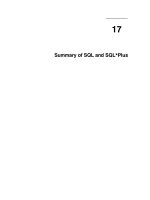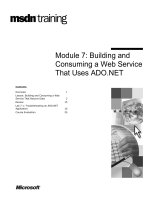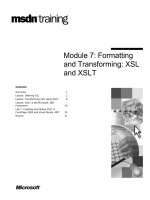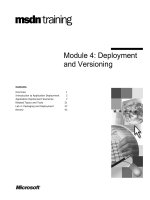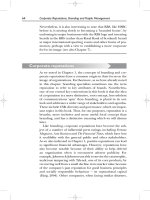Tài liệu National Strategy, Roles, and Responsibilities Need to Be Better Defined and More Effectively Implemented docx
Bạn đang xem bản rút gọn của tài liệu. Xem và tải ngay bản đầy đủ của tài liệu tại đây (2.5 MB, 112 trang )
GAO
February 2013
United States Government Accountability Office
Report to Congressional Addressees
CYBERSECURITY
National Strategy,
Roles, and
Responsibilities Need
to Be Better Defined
and More Effectively
Implemented
GAO-13-187
February 2013
CYBERSECURITY
Highlights of GAO-13-187, a report to
congressional addressees
National Strategy, Roles, and Responsibilities Need
to Be Better Defined and More Effectively
Implemented
Why GAO Did This Study
What GAO Found
Cyber attacks could have a potentially
devastating impact on the nation’s
computer systems and networks,
disrupting the operations of
government and businesses and the
lives of private individuals. Increasingly
sophisticated cyber threats have
underscored the need to manage and
bolster the cybersecurity of key
government systems as well as the
nation’s critical infrastructure. GAO has
designated federal information security
as a government-wide high-risk area
since 1997, and in 2003 expanded it to
include cyber critical infrastructure.
GAO has issued numerous reports
since that time making
recommendations to address
weaknesses in federal information
security programs as well as efforts to
improve critical infrastructure
protection. Over that same period, the
executive branch has issued strategy
documents that have outlined a variety
of approaches for dealing with
persistent cybersecurity issues.
Threats to systems supporting critical infrastructure and federal operations are
evolving and growing. Federal agencies have reported increasing numbers of
cybersecurity incidents that have placed sensitive information at risk, with
potentially serious impacts on federal and military operations; critical
infrastructure; and the confidentiality, integrity, and availability of sensitive
government, private sector, and personal information. The increasing risks are
demonstrated by the dramatic increase in reports of security incidents, the ease
of obtaining and using hacking tools, and steady advances in the sophistication
and effectiveness of attack technology. As shown in the figure below, the number
of incidents reported by federal agencies to the U.S. Computer Emergency
Readiness Team has increased 782 percent from 2006 to 2012.
Incidents Reported by Federal Agencies in Fiscal Years 2006-2012
GAO’s objectives were to (1) identify
challenges faced by the federal
government in addressing a strategic
approach to cybersecurity, and (2)
determine the extent to which the
national cybersecurity strategy adheres
to desirable characteristics for such a
strategy. To address these objectives,
GAO analyzed previous reports and
updated information obtained from
officials at federal agencies with key
cybersecurity responsibilities. GAO
also obtained the views of experts in
information technology management
and cybersecurity and conducted a
survey of chief information officers at
major federal agencies.
View GAO-13-187. For more information,
contact Gregory C. Wilshusen at (202) 5126244 or or Dr. Nabajyoti
Barkakati at (202) 512-4499 or
United States Government Accountability Office
Highlights of GAO-13-187 (Continued)
GAO and inspector general reports have identified a number of key challenge areas in the federal government’s approach
to cybersecurity, including those related to protecting the nation’s critical infrastructure. While actions have been taken to
address aspects of these, issues remain in each of these challenge areas, including:
• Designing and implementing risk-based federal and critical infrastructure programs. Shortcomings persist in
assessing risks, developing and implementing controls, and monitoring results in both the federal government and
critical infrastructure. For example, in the federal arena, 8 of 22 major agencies reported compliance with risk
management requirements under the Federal Information Security Management Act (FISMA), down from 13 out of 24
the year before. In the critical infrastructure arena, the Department of Homeland Security (DHS) and the other sectorspecific agencies have not yet identified cybersecurity guidance applicable to or widely used in each of the critical
sectors. GAO has continued to make numerous recommendations to address weaknesses in risk management
processes at individual federal agencies and to further efforts by sector-specific agencies to enhance critical
infrastructure protection.
• Detecting, responding to, and mitigating cyber incidents. DHS has made incremental progress in coordinating the
federal response to cyber incidents, but challenges remain in sharing information among federal agencies and key
private sector entities, including critical infrastructure owners, as well as in developing a timely analysis and warning
capability. Difficulties in sharing and accessing classified information and the lack of a centralized information-sharing
system continue to hinder progress. According to DHS, a secure environment for sharing cybersecurity information, at
all classification levels, is not expected to be fully operational until fiscal year 2018. Further, although DHS has taken
steps to establish timely analysis and warning, GAO previously reported that the department had yet to establish a
predictive analysis capability and recommended that DHS expand capabilities to investigate incidents. According to
the department, tools for predictive analysis are to be tested in fiscal year 2013.
• Promoting education, awareness, and workforce planning. In November 2011, GAO reported that agencies
leading strategic planning efforts for education and awareness, including Commerce, the Office of Management and
Budget (OMB), the Office of Personnel Management, and DHS, had not developed details on how they were going to
achieve planned outcomes and that the specific tasks and responsibilities were unclear. GAO recommended, among
other things, that the key federal agencies involved in the initiative collaborate to clarify responsibilities and processes
for planning and monitoring their activities. GAO also reported that only 2 of 8 agencies it reviewed developed cyber
workforce plans and only 3 of the 8 agencies had a department-wide training program for their cybersecurity
workforce. GAO recommended that these agencies take a number of steps to improve agency and government-wide
cybersecurity workforce efforts. The agencies generally agreed with the recommendations.
• Promoting research and development (R&D). The goal of supporting targeted cyber R&D has been impeded by
implementation challenges among federal agencies. In June 2010, GAO reported that R&D initiatives were hindered
by limited sharing of detailed information about ongoing research, including the lack of a repository to track R&D
projects and funding, as required by law. GAO recommended that a mechanism be established for tracking ongoing
and completed federal cybersecurity R&D projects and associated funding, and that this mechanism be utilized to
develop an ongoing process to make federal R&D information available to federal agencies and the private sector.
However, as of September 2012, this mechanism had not yet been fully developed.
• Addressing international cybersecurity challenges. While progress has been made in identifying the importance
of international cooperation and assigning roles and responsibilities related to it, the government’s approach to
addressing international aspects of cybersecurity has not yet been completely defined and implemented. GAO
recommended in July 2010 that the government develop an international strategy that specified outcome-oriented
performance metrics and timeframes for completing activities. While an international strategy for cyberspace has been
developed, it does not fully specify outcome-oriented performance metrics or timeframes for completing activities.
The government has issued a variety of strategy-related documents over the last decade, many of which address aspects
of the above challenge areas. The documents address priorities for enhancing cybersecurity within the federal
government as well as for encouraging improvements in the cybersecurity of critical infrastructure within the private
sector. However, no overarching cybersecurity strategy has been developed that articulates priority actions, assigns
responsibilities for performing them, and sets timeframes for their completion. In 2004, GAO developed a set of desirable
characteristics that can enhance the usefulness of national strategies in allocating resources, defining policies, and
helping to ensure accountability. Existing cybersecurity strategy documents have included selected elements of these
desirable characteristics, such as setting goals and subordinate objectives, but have generally lacked other key elements.
The missing elements include:
•
Milestones and performance measures. The government’s strategy documents include few milestones or
performance measures, making it difficult to track progress in accomplishing stated goals and objectives. The lack of
United States Government Accountability Office
Highlights of GAO-13-187 (Continued)
•
•
•
milestones and performance measures at the strategic level is mirrored in similar shortcomings within key government
programs that are part of the government-wide strategy. The DHS inspector general, for example, recommended in
2011 that DHS develop and implement performance measures to be used to track and evaluate the effectiveness of
actions defined in its strategic implementation plan. As of January 2012, DHS had not yet developed the performance
measures but planned to do so.
Cost and resources. While past strategy documents linked certain activities to budget submissions, none have fully
addressed cost and resources, including justifying the required investment, which is critical to gaining support for
implementation. In addition, none provided full assessments of anticipated costs and how resources might be
allocated to address them.
Roles and responsibilities. Cybersecurity strategy documents have assigned high-level roles and responsibilities
but have left important details unclear. Several GAO reports have likewise demonstrated that the roles and
responsibilities of key agencies charged with protecting the nation’s cyber assets are inadequately defined. For
example, the chartering directives for several offices within the Department of Defense assign overlapping roles and
responsibilities for preparing for and responding to domestic cyber incidents. In an October 2012 report, GAO
recommended that the department update its guidance on preparing for and responding to domestic cyber incidents
to include a description of its roles and responsibilities. In addition, it is unclear how OMB and DHS are to share
oversight of individual departments and agencies. While the law gives OMB responsibility for oversight of federal
government information security, OMB transferred several of its oversight responsibilities to DHS. Both DHS and
OMB have issued annual FISMA reporting instructions to agencies, which could create confusion among agency
officials because the instructions vary in content. Clarifying oversight responsibilities is a topic that could be effectively
addressed through legislation.
Linkage with other key strategy documents. Existing cybersecurity strategy documents vary in terms of priorities
and structure, and do not specify how they link to or supersede other documents, nor do they describe how they fit
into an overarching national cybersecurity strategy. For example, in 2012, the administration determined that trusted
Internet connections, continuous monitoring, and strong authentication should be cross-agency priorities, but no
explanation was given as to how these three relate to priorities previously established in other strategy documents.
The many continuing cybersecurity challenges faced by the government highlight the need for a clearly defined oversight
process to ensure agencies are held accountable for implementing effective information security programs. Further, until
an overarching national cybersecurity strategy is developed that addresses all key elements of desirable characteristics,
overall progress in achieving the government's objectives is likely to remain limited.
What GAO Recommends
To address missing elements in the national cybersecurity strategy, such as milestones and performance measures, cost
and resources, roles and responsibilities, and linkage with other key strategy documents, GAO recommends that the
White House Cybersecurity Coordinator develop an overarching federal cybersecurity strategy that includes all key
elements of the desirable characteristics of a national strategy. Such a strategy would provide a more effective framework
for implementing cybersecurity activities and better ensure that such activities will lead to progress in cybersecurity.
This strategy should also better ensure that federal departments and agencies are held accountable for making significant
improvements in cybersecurity challenge areas, including designing and implementing risk-based programs; detecting,
responding to, and mitigating cyber incidents; promoting education, awareness, and workforce planning; promoting R&D;
and addressing international cybersecurity challenges. To address these issues, the strategy should (1) clarify how OMB
will oversee agency implementation of requirements for effective risk management processes and (2) establish a roadmap
for making significant improvements in cybersecurity challenge areas where previous recommendations have not been
fully addressed.
Further, to address ambiguities in roles and responsibilities that have resulted from recent executive branch actions, GAO
believes Congress should consider legislation to better define roles and responsibilities for implementing and overseeing
federal information security programs and for protecting the nation’s critical cyber assets.
In its comments, the Executive Office of the President agreed that more needs to be done to develop a coherent and
comprehensive strategy on cybersecurity but did not believe producing another strategy document would be beneficial.
However, GAO believes an overarching strategy document that includes milestones and performance measures, cost and
resources, roles and responsibilities, and linkage with other key strategy documents would provide a more effective
framework for implementing cybersecurity activities. The Executive Office of the President also agreed that Congress
should consider enhanced cybersecurity legislation.
United States Government Accountability Office
Contents
Letter
1
Background
Federal Strategy Has Evolved Over Time but Is Not Fully Defined
The Federal Government Continues to Face Challenges in
Implementing Cybersecurity that Could Be Addressed by an
Effective Strategy
Conclusions
Recommendations for Executive Action
Matter for Congressional Consideration
Agency Comments and Our Evaluation
3
19
Appendix I
Objectives, Scope, and Methodology
88
Appendix II
List of Panel and Survey Participants
91
Appendix III
Comments from the Department of Homeland Security
95
Appendix IV
GAO Contacts and Staff Acknowledgments
98
Related GAO Products
36
81
82
83
83
99
Tables
Table 1: Sources of Adversarial Threats to Cybersecurity
Table 2: Types of Cyber Attacks
Table 3: Summary of Desirable Characteristics for a National
Strategy
5
6
29
Figures
Figure 1: Incidents Reported to US-CERT: Fiscal Years 2006-2012
Figure 2: Incidents Reported to US-CERT by Federal Agencies in
Fiscal Year 2012 by Category
Page i
8
9
GAO-13-187 Cybersecurity Strategy
Figure 3: Evolution of National Strategies Related to Cybersecurity
Figure 4: NIST Risk Management Process Applied Across the Tiers
Figure 5: Percentage of Continuous Monitoring Capabilities
Reported by Agencies in Fiscal Year 2011
Page ii
20
38
44
GAO-13-187 Cybersecurity Strategy
Abbreviations
CIO
CNCI
CS&C
DHS
DOD
DOT
E3A
FISMA
GPRA
HHS
HSPD-7
ISAC
JACKE
NASA
NCCIC
NICE
NIPP
NIST
NITRD
OMB
OPM
OSTP
R&D
TSP
US-CERT
USGCB
VA
chief information officer
Comprehensive National Cybersecurity Initiative
Office of Cybersecurity and Communication
Department of Homeland Security
Department of Defense
Department of Transportation
EINSTEIN 3 Accelerated
Federal Information Security Management Act
Government Performance and Results Act
Department of Health and Human Services
Homeland Security Presidential Directive 7
Information Sharing and Analysis Center
Joint Agency Cyber Knowledge Exchange
National Aeronautics and Space Administration
National Cybersecurity and Communications Integration
Center
National Initiative for Cybersecurity Education
National Infrastructure Protection Plan
National Institute of Standards and Technology
Subcommittee on Networking and Information Technology
Research and Development
Office of Management and Budget
Office of Personnel Management
Office of Science and Technology Policy
research and development
Thrift Savings Plan
United States Computer Emergency Readiness Team
United States Government Configuration Baseline
Department of Veterans Affairs
This is a work of the U.S. government and is not subject to copyright protection in the
United States. The published product may be reproduced and distributed in its entirety
without further permission from GAO. However, because this work may contain
copyrighted images or other material, permission from the copyright holder may be
necessary if you wish to reproduce this material separately.
Page iii
GAO-13-187 Cybersecurity Strategy
United States Government Accountability Office
Washington, DC 20548
February 14, 2013
Congressional Addressees
The pervasive use of the Internet has revolutionized the way that our
government, our nation, and the rest of the world communicates and
conducts business. While the benefits have been enormous, this
widespread connectivity also poses significant risks to the government’s
and our nation’s computer systems and networks as well as the critical
operations and key infrastructures they support. The speed and
accessibility that create the enormous benefits of the computer age, if not
properly controlled, can allow unauthorized individuals and organizations
to inexpensively eavesdrop on or interfere with these operations from
remote locations for potentially malicious purposes, including fraud or
sabotage. Increasingly sophisticated cyber threats have underscored the
need to manage and bolster the cybersecurity of key government
systems as well as the nation’s critical infrastructure. 1
Federal law and policy call for a risk-based approach to managing
cybersecurity within the government and also specify activities to
enhance the cybersecurity of public and private infrastructures that are
essential to national security, national economic security, and public
health and safety. 2 Over the last 12 years, the federal government has
developed a number of strategies and plans for addressing cybersecurity
based on this legal framework, including the National Strategy to Secure
Cyberspace, issued in February 2003, and subsequent plans and
strategies that address specific sectors, issues, and revised priorities.
We performed our work on the initiative of the U.S. Comptroller General
to evaluate the federal government’s cybersecurity strategies and
understand the status of federal cybersecurity efforts to address
challenges in establishing a strategic cybersecurity approach. Our
objectives were to (1) determine the extent to which the national
1
Critical infrastructure includes systems and assets so vital to the United States that their
incapacity or destruction would have a debilitating impact on national security.
2
This includes the Federal Information Security Management Act of 2002 (FISMA), the
Homeland Security Act of 2002, and the Homeland Security Presidential Directive 7,
among other laws and directives.
Page 1
GAO-13-187 Cybersecurity Strategy
cybersecurity strategy includes key desirable characteristics of effective
strategies, and (2) identify challenges faced by the federal government in
addressing a strategic approach to cybersecurity.
To address our objectives, we analyzed key documents that reflect the
federal government’s evolving cybersecurity strategy, as well as other
pertinent national strategies to determine the extent to which they
included GAO’s key desirable characteristics of a national strategy. In
addition, we reviewed our previous reports and reports by agency
inspectors general to identify key challenge areas. We also interviewed
representatives from federal agencies with government-wide
responsibilities for cybersecurity, including the Executive Office of the
President, Office of Management and Budget (OMB), the Departments of
Homeland Security (DHS) and Defense (DOD), and the National Institute
of Standards and Technology (NIST), to obtain their views on
cybersecurity issues as well as updated information about strategic
initiatives. We also obtained expert perspective on key issues through
use of two expert panels as well as surveys of cybersecurity experts and
the chief information officers (CIO) of the 24 major federal agencies
covered by the Chief Financial Officers Act. 3
We conducted this performance audit from April 2012 to February 2013 in
accordance with generally accepted government auditing standards.
Those standards require that we plan and perform the audit to obtain
sufficient, appropriate evidence to provide a reasonable basis for our
findings and conclusions based on our audit objectives. We believe that
the evidence obtained provides a reasonable basis for our findings and
conclusions based on our audit objectives. A full description of our
objectives, scope, and methodology can be found in appendix I. In
addition, the names of cybersecurity and information management
experts participating in our two expert panels, as well as participants in
our expert survey and CIO survey, can be found in appendix II.
3
The 24 major departments and agencies are the Departments of Agriculture, Commerce,
Defense, Education, Energy, Health and Human Services, Homeland Security, Housing
and Urban Development, the Interior, Justice, Labor, State, Transportation, the Treasury,
and Veterans Affairs; the Environmental Protection Agency, General Services
Administration, National Aeronautics and Space Administration, National Science
Foundation, Nuclear Regulatory Commission, Office of Personnel Management, Small
Business Administration, Social Security Administration, and U.S. Agency for International
Development.
Page 2
GAO-13-187 Cybersecurity Strategy
Background
Threats to systems supporting critical infrastructure and federal
information systems are evolving and growing. Advanced persistent
threats—where adversaries that possess sophisticated levels of expertise
and significant resources to pursue its objectives repeatedly over an
extended period of time—pose increasing risks. In 2009, the President
declared the cyber threat to be “[o]ne of the most serious economic and
national security challenges we face as a nation” and stated that
“America’s economic prosperity in the 21st century will depend on
cybersecurity.” 4 The Director of National Intelligence has also warned of
the increasing globalization of cyber attacks, including those carried out
by foreign militaries or organized international crime. In January 2012, he
testified that such threats pose a critical national and economic security
concern. 5 To further highlight the importance of the threat, on October 11,
2012, the Secretary of Defense stated that the collective result of attacks
on our nation’s critical infrastructure could be “a cyber Pearl Harbor; an
attack that would cause physical destruction and the loss of life.” 6 These
growing and evolving threats can potentially affect all segments of our
society, including individuals, private businesses, government agencies,
and other entities. We have identified the protection of federal information
systems as a high-risk area for the government since 1997. 7 In 2003, this
high-risk area was expanded to include protecting systems supporting our
nation’s critical infrastructure. Each year since that time, GAO has issued
multiple reports detailing weaknesses in federal information security
programs and making recommendations to address them. A list of key
GAO products can be found at the end of this report.
Sources of Threats and
Attack Methods Vary
The evolving array of cyber-based threats facing the nation pose threats
to national security, commerce and intellectual property, and individuals.
4
President Barack Obama, “Remarks by the President on Securing Our Nation’s Cyber
Infrastructure” (Washington, D.C.: May 29, 2009).
5
James R. Clapper, Director of National Intelligence, “Unclassified Statement for the
Record on the Worldwide Threat Assessment of the US Intelligence Community for the
Senate Select Committee on Intelligence” (January 31, 2012).
6
Secretary of Defense Leon E. Panetta, “Remarks by Secretary Panetta on Cybersecurity
to the Business Executives for National Security, New York City” (New York, NY: Oct. 11,
2012).
7
See GAO, High Risk Series: An Update, GAO-11-278 (Washington, D.C.: February
2011).
Page 3
GAO-13-187 Cybersecurity Strategy
•
Threats to national security include those aimed against the systems
and networks of the U.S. government, including the U.S. military, as
well as private companies that support government activities or
control critical infrastructure. These threats may be intended to cause
harm for monetary gain or political or military advantage and can
result, among other things, in the disclosure of classified information
or the disruption of operations supporting critical infrastructure,
national defense, or emergency services.
•
Threats to commerce and intellectual property include those aimed at
obtaining the confidential intellectual property of private companies,
the U.S. government, or individuals with the aim of using that
intellectual property for economic gain. For example, product
specifications may be stolen to facilitate counterfeiting and piracy or to
gain a competitive edge over a commercial rival. In some cases, theft
of intellectual property may also have national security repercussions,
as when designs for weapon systems are compromised.
•
Threats to individuals include those that lead to the unauthorized
disclosure of personally identifiable information, such as taxpayer
data, Social Security numbers, credit and debit card information, or
medical records. The disclosure of such information could cause harm
to individuals, such as identity theft, financial loss, and
embarrassment.
The sources of these threats vary in terms of the types and capabilities of
the actors, their willingness to act, and their motives. Table 1 shows
common sources of adversarial cybersecurity threats.
Page 4
GAO-13-187 Cybersecurity Strategy
Table 1: Sources of Adversarial Threats to Cybersecurity
Threat source
Description
Bot-network operators
Bot-network operators use a network, or bot-net, of compromised, remotely controlled systems to
coordinate attacks and to distribute phishing schemes, spam, and malware attacks. The services of these
networks are sometimes made available on underground markets (e.g., purchasing a denial-of-service
attack or services to relay spam or phishing attacks).
Criminal groups
Criminal groups seek to attack systems for monetary gain. Specifically, organized criminal groups use
spam, phishing, and spyware/malware to commit identity theft, online fraud, and computer extortion.
International corporate spies and criminal organizations also pose a threat to the United States through
their ability to conduct industrial espionage and large-scale monetary theft and to hire or develop hacker
talent.
Hackers
Hackers break into networks for the thrill of the challenge, bragging rights in the hacker community,
revenge, stalking, monetary gain, and political activism, among other reasons. While gaining unauthorized
access once required a fair amount of skill or computer knowledge, hackers can now download attack
scripts and protocols from the Internet and launch them against victim sites. Thus, while attack tools have
become more sophisticated, they have also become easier to use. According to the Central Intelligence
Agency, the large majority of hackers do not have the requisite expertise to threaten difficult targets such
as critical U.S. networks. Nevertheless, the worldwide population of hackers poses a relatively high threat
of an isolated or brief disruption causing serious damage.
Insiders
The disgruntled organization insider is a principal source of computer crime. Insiders may not need a great
deal of knowledge about computer intrusions because their knowledge of a target system often allows
them to gain unrestricted access to cause damage to the system or to steal system data. The insider threat
includes contractors hired by the organization, as well as careless or poorly trained employees who may
inadvertently introduce malware into systems.
Nations
Nations use cyber tools as part of their information-gathering and espionage activities. In addition, several
nations are aggressively working to develop information warfare doctrine, programs, and capabilities. Such
capabilities enable a single entity to have a significant and serious impact by disrupting the supply,
communications, and economic infrastructures that support military power—impacts that could affect the
daily lives of citizens across the country. In his January 2012 testimony, the Director of National
Intelligence stated that, among state actors, China and Russia are of particular concern.
Phishers
Individuals or small groups execute phishing schemes in an attempt to steal identities or information for
monetary gain. Phishers may also use spam and spyware or malware to accomplish their objectives.
Spammers
Individuals or organizations distribute unsolicited e-mail with hidden or false information in order to sell
products, conduct phishing schemes, distribute spyware or malware, or attack organizations (e.g., a denial
of service).
Spyware or malware
authors
Individuals or organizations with malicious intent carry out attacks against users by producing and
distributing spyware and malware. Several destructive viruses and worms have harmed files and hard
drives, and reportedly have even caused physical damage to critical infrastructure, including the Melissa
Macro Virus, the Explore.Zip worm, the CIH (Chernobyl) Virus, Nimda, and Code Red.
Terrorists
Terrorists seek to destroy, incapacitate, or exploit critical infrastructures in order to threaten national
security, cause mass casualties, weaken the economy, and damage public morale and confidence.
Terrorists may use phishing schemes or spyware/malware in order to generate funds or gather sensitive
information.
Source: GAO analysis based on data from the Director of National Intelligence, Department of Justice, Central Intelligence Agency, and
the Software Engineering Institute’s CERT® Coordination Center.
Page 5
GAO-13-187 Cybersecurity Strategy
These sources of cybersecurity threats make use of various techniques,
or attacks that may compromise information or adversely affect
computers, software, a network, an organization’s operation, an industry,
or the Internet itself. Table 2 provides descriptions of common types of
cyber attacks.
Table 2: Types of Cyber Attacks
Types of attack
Description
Cross-site scripting
An attack that uses third-party web resources to run a script within the victim’s web browser or
scriptable application. This occurs when a browser visits a malicious website or clicks a malicious link.
The most dangerous consequences occur when this method is used to exploit additional vulnerabilities
that may permit an attacker to steal cookies (data exchanged between a web server and a browser),
log key strokes, capture screen shots, discover and collect network information, and remotely access
and control the victim’s machine.
Denial-of-service
An attack that prevents or impairs the authorized use of networks, systems, or applications by
exhausting resources.
Distributed denial-of-service
A variant of the denial-of-service attack that uses numerous hosts to perform the attack.
Logic bombs
A piece of programming code intentionally inserted into a software system that will cause a malicious
function to occur when one or more specified conditions are met.
Phishing
A digital form of social engineering that uses authentic-looking, but fake, e-mails to request information
from users or direct them to a fake website that requests information.
Passive wiretapping
The monitoring or recording of data, such as passwords transmitted in clear text, while they are being
transmitted over a communications link. This is done without altering or affecting the data.
Structured Query Language
injection
An attack that involves the alteration of a database search in a web-based application, which can be
used to obtain unauthorized access to sensitive information in a database.
Trojan horse
A computer program that appears to have a useful function, but also has a hidden and potentially
malicious function that evades security mechanisms by, for example, masquerading as a useful
program that a user would likely execute.
Virus
A computer program that can copy itself and infect a computer without the permission or knowledge of
the user. A virus might corrupt or delete data on a computer, use e-mail programs to spread itself to
other computers, or even erase everything on a hard disk. Unlike a worm, a virus requires human
involvement (usually unwitting) to propagate.
War driving
The method of driving through cities and neighborhoods with a wireless-equipped computer–
sometimes with a powerful antenna–searching for unsecured wireless networks.
Worm
A self-replicating, self-propagating, self-contained program that uses network mechanisms to spread
itself. Unlike viruses, worms do not require human involvement to propagate.
Source: GAO analysis of data from the National Institute of Standards and Technology, United States Computer Emergency Readiness
Team, and industry reports.
The unique nature of cyber-based attacks can vastly enhance their reach
and impact, resulting in the loss of sensitive information and damage to
economic and national security, the loss of privacy, identity theft, or the
compromise of proprietary information or intellectual property. The
increasing number of incidents reported by federal agencies, and the
Page 6
GAO-13-187 Cybersecurity Strategy
recently reported cyber-based attacks against individuals, businesses,
critical infrastructures, and government organizations have further
underscored the need to manage and bolster the cybersecurity of our
government’s information systems and our nation’s critical infrastructures.
Number of Incidents
Reported by Federal
Agencies Continues to
Rise, and Recently
Reported Incidents
Illustrate Potential Impact
Federal agencies have reported increasing numbers of cybersecurity
incidents that have placed sensitive information at risk, with potentially
serious impacts on federal operations, assets, and people. The increasing
risks to federal systems are demonstrated by the dramatic increase in
reports of security incidents, the ease of obtaining and using hacking
tools, and steady advances in the sophistication and effectiveness of
attack technology. As shown in figure 1, over the past 6 years, the
number of incidents reported by federal agencies to the U.S. Computer
Emergency Readiness Team (US-CERT) has increased from 5,503 in
fiscal year 2006 to 48,562 incidents in fiscal year 2012, an increase of
782 percent. These incidents include, among others, the installation of
malware, 8 improper use of computing resources, and unauthorized
access to systems.
8
Malware is malicious software and is defined as programs that are designed to carry out
annoying or harmful actions. Once installed, malware can often masquerade as useful
programs or be embedded into useful programs so that users are induced into activating
the program, spreading itself onto other devices.
Page 7
GAO-13-187 Cybersecurity Strategy
Figure 1: Incidents Reported to US-CERT: Fiscal Years 2006-2012
Of the incidents occurring in 2012 (not including those that were reported
as under investigation), improper usage, 9 malicious code, and
unauthorized access were the most widely reported types across the
federal government. As indicated in figure 2, which includes a breakout of
incidents reported to US-CERT by agencies in fiscal year 2012, improper
usage accounted for 20 percent of total incidents reported by agencies.
9
An incident is categorized as “improper usage” if a person violates acceptable computing
use policies.
Page 8
GAO-13-187 Cybersecurity Strategy
Interactive graphic
Figure 2: Incidents Reported to US-CERT by Federal Agencies in FY 2012 by Category
Directions:
Roll over the incident category to view more information.
0%
Denial of service
Scans, probes,
attempted access
Unauthorized access
Malicious code
Improper usage
Under investigation/
other
Source: GAO analysis of US-CERT data and GAO reports.
Page 9
GAO-13-187 Cybersecurity Strategy
In addition, reports of cyber incidents affecting national security,
intellectual property, and individuals have been widespread and involve
data loss or theft, economic loss, computer intrusions, and privacy
breaches. The following examples from news media and other public
sources illustrate that a broad array of information and assets remain at
risk.
Incidents Affecting National
Security
•
In February 2012, the National Aeronautics and Space Administration
(NASA) inspector general testified that computers with Chinese-based
Internet protocol addresses had gained full access to key systems at
its Jet Propulsion Laboratory, enabling attackers to modify, copy, or
delete sensitive files; create user accounts for mission-critical
laboratory systems; and upload hacking tools to steal user credentials
and compromise other NASA systems. 10 These individuals were also
able to modify system logs to conceal their actions.
•
In March 2011, attackers breached the networks of RSA, the Security
Division of EMC Corporation, 11 and obtained information about
network authentication tokens for a U.S. military contractor. In May
2011, attackers used this information to make duplicate network
authentication tokens and breached the contractor’s security systems
containing sensitive weapons information and military technology.
EMC published information about the breach and the immediate steps
customers could take to strengthen the security of their systems.
•
In 2008, the Department of Defense was successfully compromised
when an infected flash drive was inserted into a U.S. military laptop at
a military base in the Middle East. The flash drive contained malicious
computer code, placed there by a foreign intelligence agency, that
uploaded itself onto the military network, spreading through classified
and unclassified systems. According to the then Deputy Secretary of
Defense, this incident was the most significant breach of U.S. military
computers at that time, and DOD’s subsequent Strategy for Operating
10
Paul K. Martin, Inspector General, National Aeronautics and Space Administration,
“NASA Cybersecurity: An Examination of the Agency’s Information Security,” testimony
before the Subcommittee on Investigations and Oversight, Committee on Science, Space,
and Technology, House of Representatives (Washington, D.C.: Feb. 29, 2012).
11
The RSA SecureID system is the most widely used two-factor authentication solution
providing secure access to remote and mobile users.
Page 10
GAO-13-187 Cybersecurity Strategy
in Cyberspace was designed in part to prevent such attacks from
recurring in the future.
In March 2011, an individual was found guilty of distributing source
code stolen from his employer, an American company. The
investigation revealed that a Chinese company paid the individual
$1.5 million to create control system source code based on the
American company’s design. The Chinese company stopped the
delivery of the turbines from the American company, resulting in
revenue loss for the American company.
In February 2011, media reports stated that computer attackers broke
into and stole proprietary information worth millions of dollars from
networks of six U.S. and European energy companies.
•
Incidents Affecting Individuals
•
•
Incidents Affecting Commerce
and Intellectual Property
In mid-2009, a research chemist with DuPont Corporation
downloaded proprietary information to a personal e-mail account and
thumb drive with the intention of transferring this information to Peking
University in China and also sought Chinese government funding to
commercialize research related to the information he had stolen.
•
In May 2012, the Federal Retirement Thrift Investment Board 12
reported a sophisticated cyber attack on the computer of a third party
that provided services to the Thrift Savings Plan (TSP). 13 As a result
of the attack, approximately 123,000 TSP participants had their
personal information accessed. According to the board, the
information included 43,587 individuals’ names, addresses, and
Social Security numbers; and 79,614 individuals’ Social Security
numbers and other TSP-related information.
•
In March 2012, attackers breached a server that held thousands of
Medicaid records at the Utah Department of Health. Included in the
breach were the names of Medicaid recipients and clients of the
Children’s Health Insurance Plan. In addition, approximately 280,000
people had their Social Security numbers exposed, and another
12
The Federal Retirement Thrift Investment Board is an independent agency in the
executive branch governed by five presidentially appointed board members and is
responsible for administering the Thrift Savings Plan (TSP) and managing the investments
of the Thrift Savings Fund.
13
TSP is a tax-deferred defined contribution savings plan for federal employees similar to
the 401(k) plans offered by private employers.
Page 11
GAO-13-187 Cybersecurity Strategy
350,000 people listed in the eligibility inquiries may have had other
sensitive data stolen, including names, birth dates, and addresses.
•
In March 2012, Global Payments, a credit-transaction processor in
Atlanta, reported a data breach that exposed credit and debit card
account information of as many as 1.5 million accounts in North
America. Although Global Payments does not believe any personal
information was taken, it provided alerts and planned to pay for credit
monitoring for those whose personal information was at risk.
These incidents illustrate the serious impact that cyber attacks can have
on federal and military operations, critical infrastructure, and the
confidentiality, integrity, and availability of sensitive government, private
sector, and personal information.
Federal Information
Security Responsibilities
Are Established in Law
and Policy
Federal law and policy address agency responsibilities for cybersecurity
in a variety of ways, reflecting its complexity and the nature of our
country’s political and economic structure. Requirements for securing the
federal government’s information systems are addressed in federal laws
and policies. Beyond high-level critical infrastructure protection
responsibilities, the existence of a federal role in securing systems not
controlled by the federal government typically relates to the government’s
application of regulatory authority and reflects the fact that much of our
nation’s economic infrastructure is owned and controlled by the private
sector. Certain federal agencies have cybersecurity-related
responsibilities within a specific economic sector and may issue
standards and guidance. For example, the Federal Energy Regulatory
Commission approves cybersecurity standards in carrying out
responsibilities for the reliability of the nation’s bulk power system. In
sectors where the use of federal cybersecurity guidance is not mandatory,
entities may voluntarily implement such guidance in response to business
incentives, including to mitigate risks, protect intellectual property, ensure
interoperability among systems, and encourage the use of leading
practices.
Page 12
GAO-13-187 Cybersecurity Strategy
The Federal Information Security Management Act of 2002 (FISMA) 14
sets forth a comprehensive risk-based framework for ensuring the
effectiveness of information security controls over information resources
that support federal operations and assets. In order to ensure the
implementation of this framework, FISMA assigns specific responsibilities
to agencies, OMB, NIST, and inspectors general.
FISMA requires each agency to develop, document, and implement an
information security program to include, among other things,
•
periodic assessments of the risk and magnitude of harm that could
result from the unauthorized access, use, disclosure, disruption,
modification, or destruction of information or information systems;
•
policies and procedures that (1) are based on risk assessments, (2)
cost-effectively reduce information security risks to an acceptable
level, (3) ensure that information security is addressed throughout the
life cycle of each system, and (4) ensure compliance with applicable
requirements;
•
security awareness training to inform personnel of information security
risks and of their responsibilities in complying with agency policies
and procedures, as well as training personnel with significant security
responsibilities for information security;
•
periodic testing and evaluation of the effectiveness of information
security policies, procedures, and practices, to be performed with a
frequency depending on risk, but no less than annually, and that
includes testing of management, operational, and technical controls
for every system identified in the agency’s required inventory of major
information systems; and
14
Title III of the E-Government Act of 2002, Pub. L. No. 107-347, Dec. 17, 2002; 44 U.S.C
3541, et seq. This report discusses FISMA because it is the primary law specifying federal
agencies’ cybersecurity responsibilities. Other laws give federal agencies general
responsibilities that can include cybersecurity-related duties. For example, the Federal
Bureau of Investigation is responsible for detecting and prosecuting crimes under 28
U.S.C. § 533, which can include cybercrimes, and 50 U.S.C. ch. 15 addresses national
security responsibilities of national defense and intelligence agencies, which can also
include cyber-related threats to national security.
Page 13
GAO-13-187 Cybersecurity Strategy
procedures for detecting, reporting, and responding to security
incidents.
•
In addition, FISMA requires each agency to report annually to OMB,
selected congressional committees, and the U.S. Comptroller General on
the adequacy of its information security policies, procedures, practices,
and compliance with requirements.
OMB’s responsibilities include developing and overseeing the
implementation of policies, principles, standards, and guidelines on
information security in federal agencies (except with regard to national
security systems 15). It is also responsible for reviewing, at least annually,
and approving or disapproving agency information security programs.
NIST’s responsibilities under FISMA include the development of security
standards and guidelines for agencies that include standards for
categorizing information and information systems according to ranges of
risk levels, minimum security requirements for information and information
systems in risk categories, guidelines for detection and handling of
information security incidents, and guidelines for identifying an
information system as a national security system (NIST standards and
guidelines, like OMB policies, do not apply to national security systems 16).
NIST also has related responsibilities under the Cyber Security Research
and Development Act that include developing a checklist of settings and
option selections to minimize security risks associated with computer
hardware and software widely used within the federal government. 17
15
As defined in FISMA, the term “national security system” means any information system
used by or on behalf of a federal agency that (1) involves intelligence activities, national
security-related cryptologic activities, command and control of military forces, or
equipment that is an integral part of a weapon or weapons system, or is critical to the
direct fulfillment of military or intelligence missions (excluding systems used for routine
administrative and business applications); or (2) is protected at all times by procedures
established for handling classified national security information. See 44 U.S.C. §
3542(b)(2).
16
FISMA limits NIST to developing, in conjunction with DOD and the National Security
Agency, guidelines for agencies on identifying an information system as a national
security system, and for ensuring that NIST standards and guidelines are complementary
with standards and guidelines developed for national security systems.
17
Pub. L. No. 107-305 (Nov. 27, 2002); 15 U.S.C.§ 7406(c).
Page 14
GAO-13-187 Cybersecurity Strategy
FISMA also requires each agency inspector general to annually evaluate
the information security program and practices of the agency. The results
of these evaluations are submitted to OMB, and OMB is to summarize the
results in its reporting to Congress.
In the 10 years since FISMA was enacted into law, executive branch
oversight of agency information security has changed. As part of its
FISMA oversight responsibilities, OMB has issued annual guidance to
agencies on implementing FISMA requirements, including instructions for
agency and inspector general reporting. However, in July 2010, the
Director of OMB and the White House Cybersecurity Coordinator 18 issued
a joint memorandum 19 stating that DHS was to exercise primary
responsibility within the executive branch for the operational aspects of
cybersecurity for federal information systems that fall within the scope of
FISMA. The memo stated that DHS activities would include five specific
responsibilities of OMB under FISMA:
•
overseeing implementation of and reporting on government
cybersecurity policies and guidance;
•
overseeing and assisting government efforts to provide adequate,
risk-based, and cost-effective cybersecurity;
•
overseeing agencies’ compliance with FISMA;
•
overseeing agencies’ cybersecurity operations and incident response;
and
•
annually reviewing agencies’ cybersecurity programs. 20
18
In December 2009, a Special Assistant to the President was appointed as Cybersecurity
Coordinator to address the recommendations made in the Cyberspace Policy Review,
including coordinating interagency cybersecurity policies and strategies and developing a
comprehensive national strategy to secure the nation’s digital infrastructure.
19
OMB, Memorandum M-10-28, Clarifying Cybersecurity Responsibilities and Activities of
the Executive Office of the President and the Department of Homeland Security
(Washington, D.C.: July 6, 2010).
20
As used in OMB M-10-28, the term cybersecurity applies to activities undertaken to
provide information security as defined by FISMA.
Page 15
GAO-13-187 Cybersecurity Strategy
The OMB memo also stated that in carrying out these responsibilities,
DHS is to be subject to general OMB oversight in accordance with the
provisions of FISMA. In addition, the memo stated that the Cybersecurity
Coordinator would lead the interagency process for cybersecurity strategy
and policy development. Subsequent to the issuance of M-10-28, DHS
began issuing annual reporting instructions to agencies in addition to
OMB’s annual guidance. 21
In addition to FISMA’s information security program provisions, federal
agencies operating national security systems must also comply with
requirements for enhanced protections for those sensitive systems.
National Security Directive 42 established the Committee on National
Security Systems, an organization chaired by the Department of Defense,
to, among other things, issue policy directives and instructions that
provide mandatory information security requirements for national security
systems. 22 In addition, the defense and intelligence communities develop
implementing instructions and may add additional requirements where
needed. The Department of Defense also has particular responsibilities
for cybersecurity issues related to national defense. To address these
issues, DOD has undertaken a number of initiatives, including
establishing the U.S. Cyber Command. 23 An effort is underway to
harmonize policies and guidance for national security and non-national
security systems. Representatives from civilian, defense, and intelligence
agencies established a joint task force in 2009, led by NIST and including
senior leadership and subject matter experts from participating agencies,
to publish common guidance for information systems security for national
security and non-national security systems. 24
21
Fiscal year 2011 reporting instructions for the Federal Information Security Management
Act and agency privacy management were issued by DHS, as Federal Information
Security Memorandum (FISM) 11-02 (Aug. 24, 2011), and by OMB, as M-11-33 (Sept. 14,
2011). Fiscal year 2012 reporting instructions were issued by DHS, as FISM 12-02 (Feb.
15, 2012), and by OMB, as M-12-20 (Sept. 27, 2012). While identically titled, these
memos varied in content.
22
National Security Directive 42, National Policy for the Security of National Security
Telecommunications and Information Systems (July 5, 1990).
23
See GAO, Defense Department Cyber Efforts: DOD Faces Challenges in its Cyber
Activities, GAO-11-75 (Washington, D.C.: July 25, 2011).
24
See GAO, Information Security: Progress Made in Harmonizing Policies and Guidance
for National Security and Non-National Security Systems, GAO-10-916 (Washington,
D.C.: Sept. 15, 2010).
Page 16
GAO-13-187 Cybersecurity Strategy
Various laws and directives have also given federal agencies
responsibilities relating to the protection of critical infrastructures, which
are largely owned by private sector organizations. 25 The Homeland
Security Act of 2002 created the Department of Homeland Security.
Among other things, DHS was assigned with the following critical
infrastructure protection responsibilities: (1) developing a comprehensive
national plan for securing the critical infrastructures of the United States,
(2) recommending measures to protect those critical infrastructures in
coordination with other groups, and (3) disseminating, as appropriate,
information to assist in the deterrence, prevention, and preemption of, or
response to, terrorist attacks.
Homeland Security Presidential Directive 7 (HSPD-7) was issued in
December 2003 and defined additional responsibilities for DHS, sectorspecific agencies, 26 and other departments and agencies. The directive
instructs sector-specific agencies to collaborate with the private sector to
identify, prioritize, and coordinate the protection of critical infrastructures
to prevent, deter, and mitigate the effects of attacks. It also makes DHS
responsible for, among other things, coordinating national critical
infrastructure protection efforts and establishing uniform policies,
approaches, guidelines, and methodologies for integrating federal
infrastructure protection and risk management activities within and across
sectors.
The recently concluded 112th Congress considered enacting new
legislation to address federal information security oversight
responsibilities. For example, the Cybersecurity Act of 2012, S. 3414,
which was endorsed by the Obama administration with its July 26, 2012,
Statement of Administration Policy, proposed to amend FISMA to give
OMB’s statutory oversight responsibilities to DHS. 27 The SECURE IT Act,
S. 3342, would have given the Department of Commerce that oversight
25
See GAO, Critical Infrastructure Protection: Cybersecurity Guidance Is Available, but
More Can Be Done to Promote Its Use (Washington, D.C.: Dec. 9, 2011) for a more indepth discussion on the responsibilities of the federal government as they relate to critical
infrastructure protection.
26
Sector-specific agencies are federal agencies designated to be focal points for specific
critical infrastructure sectors.
27
S.3414, among other things, also addressed cybersecurity workforce issues,
cybersecurity research and development, and critical infrastructure protection.
Page 17
GAO-13-187 Cybersecurity Strategy
responsibility in consultation with DHS. 28 The Federal Information
Security Amendments Act of 2012, H.R. 4257, proposed to preserve
OMB’s FISMA oversight duties. The Executive Cyberspace Coordination
Act of 2011, H.R. 1136, would have given OMB’s role to a newly created
National Office for Cyberspace in the Executive Office of the President. 29
While H.R. 4257 was passed by the House of Representatives, none of
these bills were enacted into law during the recently completed 112th
Congress.
Strategic Approaches to
Cybersecurity Can Help
Organizations Focus on
Objectives
Implementing a comprehensive strategic approach to cybersecurity
requires the development of strategy documents to guide the activities
that will support this approach. These strategy documents are starting
points that define the problems and risks intended to be addressed by
organizations as well as plans for tackling those problems and risks,
allocating and managing the appropriate resources, identifying different
organizations’ roles and responsibilities, and linking (or integrating) all
planned actions. As envisioned by the Government Performance and
Results Act (GPRA) of 1993, 30 developing a strategic plan can help clarify
organizational priorities and unify employees in the pursuit of shared
goals.
Such a plan can be of particular value in linking long-term performance
goals and objectives horizontally across multiple organizations. In
addition, it provides a basis for integrating, rather than merely
coordinating, a wide array of activities. If done well, strategic planning is
continuous and provides the basis for the important activities an
organization does each day, moving it closer to accomplishing its ultimate
objectives. By more closely aligning its activities, processes, and
resources with its goals, the government can be better positioned to
accomplish those goals.
28
S.3342, among other things, also addressed cybersecurity workforce issues,
cybersecurity research and development, and cybercrime.
29
H.R.1136, among other things, also addressed supply chain security and critical
infrastructure protection.
30
GPRA, Pub. L. No. 103-62, 107 Stat. 285 (1993).
Page 18
GAO-13-187 Cybersecurity Strategy

